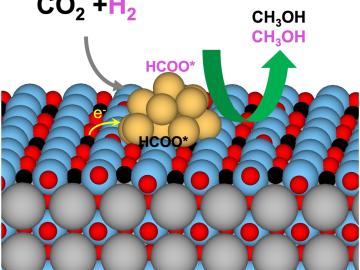Filter News
Area of Research
- Advanced Manufacturing (29)
- Biological Systems (17)
- Biology and Environment (74)
- Biology and Soft Matter (1)
- Building Technologies (10)
- Chemical and Engineering Materials (1)
- Chemistry and Physics at Interfaces (4)
- Clean Energy (339)
- Climate and Environmental Systems (6)
- Computational Biology (5)
- Computational Engineering (4)
- Computer Science (16)
- Electricity and Smart Grid (2)
- Energy Frontier Research Centers (7)
- Energy Sciences (5)
- Fossil Energy (3)
- Fuel Cycle Science and Technology (1)
- Functional Materials for Energy (8)
- Fusion and Fission (23)
- Fusion Energy (10)
- Geographic Information Science and Technology (2)
- Isotope Development and Production (2)
- Isotopes (15)
- Materials (301)
- Materials Characterization (2)
- Materials for Computing (23)
- Materials Synthesis from Atoms to Systems (5)
- Materials Under Extremes (5)
- Mathematics (1)
- National Security (33)
- Neutron Data Analysis and Visualization (2)
- Neutron Science (115)
- Nuclear Science and Technology (45)
- Nuclear Systems Modeling, Simulation and Validation (3)
- Nuclear Systems Technology (1)
- Quantum Condensed Matter (1)
- Quantum information Science (5)
- Reactor Technology (1)
- Renewable Energy (2)
- Sensors and Controls (3)
- Supercomputing (156)
- Transportation Systems (7)
News Type
Date
News Topics
- 3-D Printing/Advanced Manufacturing (80)
- Advanced Reactors (25)
- Artificial Intelligence (44)
- Big Data (26)
- Bioenergy (39)
- Biology (40)
- Biomedical (29)
- Biotechnology (10)
- Buildings (34)
- Chemical Sciences (40)
- Clean Water (14)
- Climate Change (45)
- Composites (19)
- Computer Science (100)
- Coronavirus (28)
- Critical Materials (23)
- Cybersecurity (21)
- Decarbonization (29)
- Education (3)
- Element Discovery (1)
- Energy Storage (75)
- Environment (87)
- Exascale Computing (13)
- Fossil Energy (1)
- Frontier (17)
- Fusion (23)
- Grid (37)
- High-Performance Computing (42)
- Hydropower (6)
- Irradiation (3)
- Isotopes (25)
- ITER (5)
- Machine Learning (24)
- Materials (104)
- Materials Science (87)
- Mathematics (1)
- Mercury (5)
- Microscopy (29)
- Molten Salt (7)
- Nanotechnology (40)
- National Security (23)
- Net Zero (4)
- Neutron Science (83)
- Nuclear Energy (50)
- Partnerships (28)
- Physics (28)
- Polymers (21)
- Quantum Computing (14)
- Quantum Science (38)
- Renewable Energy (1)
- Security (12)
- Simulation (17)
- Software (1)
- Space Exploration (13)
- Statistics (3)
- Summit (27)
- Sustainable Energy (79)
- Transformational Challenge Reactor (4)
- Transportation (64)
Media Contacts

Building innovations from ORNL will be on display in Washington, D.C. on the National Mall June 7 to June 9, 2024, during the U.S. Department of Housing and Urban Development’s Innovation Housing Showcase. For the first time, ORNL’s real-time building evaluator was demonstrated outside of a laboratory setting and deployed for building construction.

Lætitia H. Delmau, a distinguished researcher and radiochemist at Oak Ridge National Laboratory, has received the 2024 Glenn T. Seaborg Actinide Separations Award.

Vanderbilt University and ORNL announced a partnership to develop training, testing and evaluation methods that will accelerate the Department of Defense’s adoption of AI-based systems in operational environments.

ORNL scientists develop a sample holder that tumbles powdered photochemical materials within a neutron beamline — exposing more of the material to light for increased photo-activation and better photochemistry data capture.

ORNL researchers used electron-beam additive manufacturing to 3D-print the first complex, defect-free tungsten parts with complex geometries.

Robert Wagner, associate laboratory director for ORNL's Energy Science and Technology Directorate, has been selected to receive the George Westinghouse Gold Medal from the American Society of Mechanical Engineers, or ASME. The award recognizes his work to advance state-of-the-art clean power generation systems through research on combustion, fuel technologies and controls.

A technology developed by Oak Ridge National Laboratory works to keep food refrigerated with phase change materials, or PCMs, while reducing carbon emissions by 30%.

Scientists have uncovered the properties of a rare earth element that was first discovered 80 years ago at the very same laboratory, opening a new pathway for the exploration of elements critical in modern technology, from medicine to space travel.

A team of scientists led by ORNL found an unconventional way to improve catalysts made of more than one material. The solution demonstrates a path to designing catalysts with greater activity, selectivity and stability.

Researchers at ORNL are developing battery technologies to fight climate change in two ways, by expanding the use of renewable energy and capturing airborne carbon dioxide.




